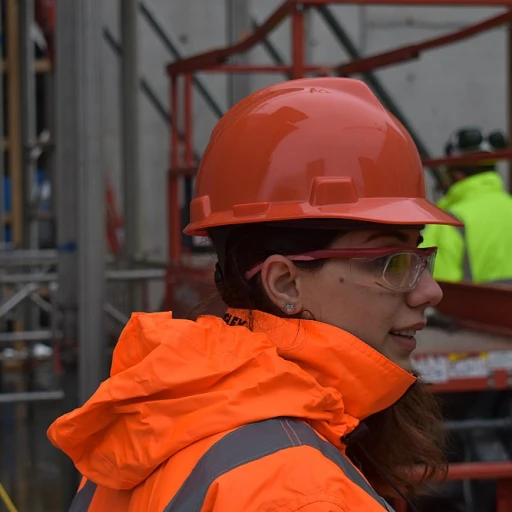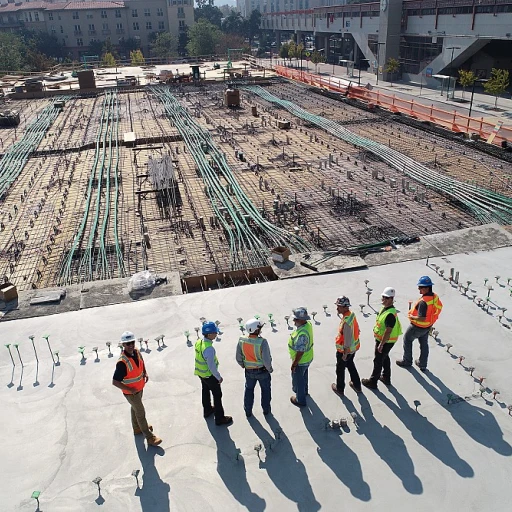Understanding the Role of Feedback in Employee Experience
The Impact of Feedback on Employee Experience
Feedback plays a pivotal role in shaping the employee experience. It's not just about ticking boxes or filling out forms; it's about creating a meaningful dialogue that can enhance employee engagement and performance. In a company where feedback is encouraged, employees feel more connected and valued, leading to a positive workplace culture.
Imagine a team where feedback is a regular part of the workday. Employees are more likely to be engaged and motivated when they know their efforts are recognized and their voices heard. Feedback loops, whether through employee surveys or real-time check-ins, provide valuable insights into areas of improvement, helping both managers and team members grow.
Feedback as a Tool for Continuous Improvement
Continuous feedback is essential for maintaining a healthy work environment. When feedback is provided in real time, it allows for immediate adjustments and fosters a culture of ongoing improvement. This approach not only boosts employee performance but also strengthens the overall organization.
For instance, regular feedback can help identify potential issues before they escalate, ensuring that employees remain satisfied and productive. It also empowers employees to take ownership of their roles, enhancing their experience and commitment to the company.
Incorporating feedback into the daily routine can significantly boost the employee experience for better productivity. By fostering an environment where feedback is valued, companies can create a more engaged and motivated workforce, ultimately leading to greater success.
Types of Feedback: Formal and Informal
Formal and Informal Paths to Employee Feedback
Well, the truth is, there ain't no one-size-fits-all when it comes to feedback, let alone employee feedback, and understanding the paths chosen by different establishments can give us insight into how they shape the work environment for employees.Formal feedback is like a well-rehearsed play. Employees often encounter it in performance reviews, employee surveys, and periodic appraisals. These channels can cover the gamut from good ole' annual reviews to regular feedback sessions, designed to help employees feel clearer about their performance, expectations, and areas for improvement. On the flip side, there’s informal feedback. Picture casual chats in the breakroom, spontaneous check ins by managers, or real time feedback during a team meeting. It’s more about creating a culture where feedback flows naturally, helping the workforce feel more engaged and part of the loop.
H3>Gains from Giving Constructive Feedback When it's done right, constructive feedback is worth its weight in gold. It carves a path toward positive paths, both for the company culture and employees' growth.
- Improved Performance: Regular feedback keeps employees on their toes, enhancing employee performance as they get the chance to work on areas they might not have even noticed needed a little tweaking.
- Boosted Engagement: When employees realize they matter and are listened to, it boosts their morale. Engagement levels soar when feedback loops are open and active.
- Enhanced Relationships: A feedback culture fosters openness, paving the way for stronger bonds between teams and managers. It's a win-win!
H3>Pitfalls in Providing Effective Feedback For all the good, giving feedback doesn’t come without its share of bumps in the road. Employees might fear negative consequences or feel their voice is just getting lost in translation. Managers might struggle with finding the time or the right words to say, especially when negative feedback is necessary. In some organizations, people may dread feedback sessions — the kind that sparks more anxiety than a Monday morning meeting. But addressing these challenges head-on can lead to feedback that's not only effective but welcomed with open arms.
Checking out new employee experience trends can provide more insights on how to evolve these practices into something truly awesome.
The Benefits of Constructive Feedback
Unlocking the Potential of Constructive Feedback
Constructive feedback can be likened to GPS for a journey – it's all about guiding employees on their path to success. By focusing on what's genuinely helpful, organizations can transform feedback into a source of growth and motivation. Imagine an employee named Sarah who works tirelessly but feels her efforts go unnoticed. One-on-one feedback sessions provide an invaluable opportunity for her manager to recognize her hard work. By highlighting her strengths while gently pointing out areas for improvement through real-time feedback, Sarah understands her contribution and can make necessary adjustments. Feedback can indeed foster a sense of belonging and boost employee engagement, as workers feel valued and understood by their peers and managers. When employees receive regular feedback, they tend to feel more connected to the company's goals, enhancing their overall employee experience. The power of constructive feedback lies in its ability to dig below the surface and provide insights into performance that might not be captured in broad employee surveys. It creates a dialogue, allowing for continuous feedback loops between employees and management, and helps in aligning personal outcomes with organizational objectives. For businesses, it's crucial to establish a feedback-rich culture where giving and receiving feedback is second nature. Employees flourish in environments where feedback encourages growth rather than instilling fear. Encouraging regular feedback, through scheduled check-ins or surveys, helps develop this culture and may contribute significantly to building a thriving workplace. However, managers play a crucial role in delivering feedback effectively. They need to ensure that feedback is fair and accurate, avoiding the pitfalls of bias. Utilizing performance management tools can sharpen feedback delivery by providing reliable data to support comments. Constructive feedback is a two-way street, benefiting both employees and the company. By nurturing a feedback culture, organizations can create workplaces where continual improvement is valued and reinforced, leading to better employee performance and increased engagement. For a detailed guide on improving your employee experience programs to boost engagement, check out this article.Challenges in Delivering Effective Feedback
Overcoming Hurdles in Giving Feedback
Feedback is a game-changer in shaping employee experience, but let's face it, delivering it effectively isn't always a walk in the park. Many managers and team leads find themselves in a pickle, trying to balance honesty with empathy. It's not just about pointing out areas for improvement; it's about doing it in a way that makes employees feel valued and motivated.
One of the biggest challenges is timing. Real-time feedback is ideal, but in the hustle and bustle of work, it often gets postponed. When feedback is delayed, it loses its impact, making it harder for employees to connect it with their performance. Regular check-ins can help, but they need to be consistent to be effective.
Another hurdle is the emotional aspect. No one likes to hear criticism, even if it's constructive. Managers need to be trained to provide feedback that is not just critical but also positive and supportive. It's a fine line between being honest and being harsh, and getting it wrong can lead to disengagement.
Then there's the issue of bias. Feedback can sometimes be colored by personal biases, leading to unfair assessments. Organizations need to ensure that feedback is based on objective criteria and not personal opinions. Employee surveys and 360-degree feedback can provide a more rounded view, helping to eliminate bias.
Lastly, the lack of feedback culture can be a significant barrier. In some workplaces, feedback is rare or even non-existent. Creating a culture where feedback is a regular part of the workday can be challenging, but it's crucial for employee engagement and performance management. Encouraging open communication and continuous feedback loops can help foster this culture.
Addressing these challenges requires a committed effort from the entire organization. Managers need to be trained, systems need to be in place, and most importantly, employees need to feel safe and supported when receiving feedback. Only then can feedback truly enhance the employee experience and drive performance.
Creating a Feedback-Rich Culture
Fostering a Culture That Welcomes Feedback
Creating a feedback-friendly vibe at work is like making your favorite dish—it involves the right ingredients, time, and a pinch of patience. When employees feel like they’re heard and their input counts, magic happens. They become more engaged, their performance takes a leap, and they're happier to be part of the team. Let’s dive into some real talks on building a feedback-loving culture:- Regular Conversations: Think of feedback as a friendly chat over a cup of coffee, not some serious once-a-year event. Regular check-ins and real-time feedback are crucial to a culture where employees feel appreciated and valued.
- Trust and Openness: Trust is like the foundation of a house—get it right, and everything stands tall. Managers should provide a safe space where employees can openly share their thoughts without fear of retribution. This comes from genuine interactions and support.
- Mix It Up: No one likes monotony, right? Mixing both formal and informal employee feedback provides a balanced approach. Formal feedback might be through performance reviews, while informal could be quick chats or impromptu recognition.
- Tools of the Trade: In today’s workplace, technology and employee surveys are there to help. Feedback tools and continuous feedback loops keep everyone on the same page. They provide a platform for everyone to voice their opinions and get instant insights.
- Celebrate Wins: When employees make progress or hit a milestone, don't just say it’s great, show it’s great! Recognizing achievements motivates employees to keep up the good work and brings positivity into the workplace.
- Get Everyone Involved: Feedback isn’t just a manager’s duty; it’s a team effort. Encourage feedback from all directions—top-down, bottom-up, and peer-to-peer. A strong feedback culture reflects positively on employee experience and engagement.
Feedback Tools and Technologies
Embracing Technology for Feedback
In an era where emojis speak volumes and tweets make headlines, feedback at work can get a tech boost too. Managers and employees alike are turning to clever tools and apps to get that feedback train rolling smoothly. Whether it's a quick comment in a chat app or filling out detailed employee surveys, these gadgets come in handy. They help the feedback arrive real time, not weeks later when the coffee’s gone cold and memories have faded.
Continuous feedback apps are now the talk of the town in many a workplace. They create feedback loops that keep employee engagement ever-green, like a pine tree in December. Such apps allow for spontaneous comments—a high-five for a job well done or a nudge towards areas improvement—without the formality of a sit-down meeting.
More Than Words
The science-y bits behind those feedback tools often involve numbers and charts. It's almost like having a heartbeat monitor for your organization. Platforms can collect data from employee surveys and churn out insights about employee performance. This, in turn, helps frame constructive feedback that employees actually understand and relate to. Voila, the art of feedback meets science!
Achieving Connection Through Technology
Technology isn't just about getting feedback quicker—it’s about connecting in new ways. Regular check ins through video chats or messaging make feedback feel more genuine. No more drab comment boxes that feel like you’re shouting into the void. When feedback comes alive through a friendly ping on their phone, employees feel they truly matter, and a positive company culture blossoms.
Feedback, whether through an app or a face-to-face chat, is a tool. And just like a chef's knife or an artist's brush, it needs the right touch. With feedback tech, companies can mold a feedback-friendly environment that empowers managers, enhances team connections, and nurtures growth.








